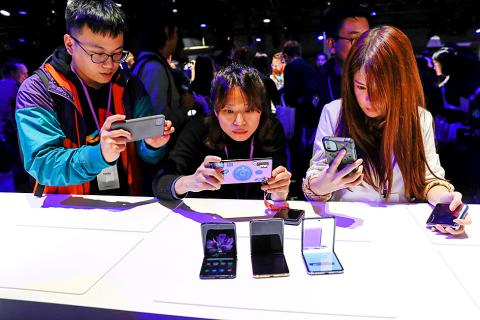Samsung Electronics Co on Tuesday unveiled a new foldable phone, the Galaxy Z Flip, its second attempt to sell consumers on phones with bendable screens and clamshell designs.
The new phone, announced at a product event in San Francisco, can unfold from a small square upward into a traditional smartphone form, and goes on sale tomorrow starting at US$1,380.
Samsung’s first foldable phone, the Galaxy Fold, finally went on sale in September last year after delays and reports of screens breaking. The Fold, which carries a price tag of nearly US$2,000, folds at a vertical crease rather than horizontally as a flip-phone design would. Motorola has also taken the flip-phone approach with its new US$1,500 Razr phone.

Photo: Reuters
The Z Flip can stay open at different angles for use watching videos or taking photos. When the phone is closed, it takes selfies and displays notifications in a small window on the cover. Unfolded, its screen measures 17cm diagonally.
Samsung says it added fibers to the gap between the hinge and the phone to keep out dust and improve hinge function, likely to address the shortcomings of the Galaxy Fold.
On the more traditional front, Samsung offers its S series. In a nod to the start of the 2020s, the South Korean company showed off the Galaxy S20, S20 Plus and S20 Ultra, skipping directly to the S20 from its previous S10 series.
The S20 phones are designed to take high-quality pictures in dark settings, Samsung product manager Mark Holloway said. The phones can take both video and photos at the same time, using artificial intelligence to zero in on the best moments to capture the still images.
Samsung’s renewed focus on the camera follows other smartphone makers. Apple Inc last fall announced the iPhone 11, which offers an additional lens for wider-angle shots and combined multiple shots with software to improve low-light images. Google’s Pixel phones also offer a similar low-light feature.
Samsung’s S phones already offer the wider angle and some features for low-lighting. However, the company says the new phones would focus on high-resolution photos and the ability to zoom in 30 to 100 times, depending on the model.
The camera on the S20 series is “a giant leap,” Moor Insights & Strategy’s Patrick Moorhead said, adding that people might gravitate toward the more expensive models even as the sales of smartphones slow.
Gartner analyst Tuong Nguyen called the S20 “astounding,” but worried that the crowd at the event had a muted response.
“I think we’ve reached the point in the technology timeline that all of us have technology that’s so good, better than we can even grasp or take advantage of, that anything new that’s introduced is not greeted with the same enthusiasm,” he said.
The S20 phones go on sale in the US on March 6, and range in price from US$1,000 to US$1,400.
All S20 models are compatible with 5G networks. The Z Flip does not work with 5G networks.

SEEKING CLARITY: Washington should not adopt measures that create uncertainties for ‘existing semiconductor investments,’ TSMC said referring to its US$165 billion in the US Taiwan Semiconductor Manufacturing Co (TSMC, 台積電) told the US that any future tariffs on Taiwanese semiconductors could reduce demand for chips and derail its pledge to increase its investment in Arizona. “New import restrictions could jeopardize current US leadership in the competitive technology industry and create uncertainties for many committed semiconductor capital projects in the US, including TSMC Arizona’s significant investment plan in Phoenix,” the chipmaker wrote in a letter to the US Department of Commerce. TSMC issued the warning in response to a solicitation for comments by the department on a possible tariff on semiconductor imports by US President Donald Trump’s

The government has launched a three-pronged strategy to attract local and international talent, aiming to position Taiwan as a new global hub following Nvidia Corp’s announcement that it has chosen Taipei as the site of its Taiwan headquarters. Nvidia cofounder and CEO Jensen Huang (黃仁勳) on Monday last week announced during his keynote speech at the Computex trade show in Taipei that the Nvidia Constellation, the company’s planned Taiwan headquarters, would be located in the Beitou-Shilin Technology Park (北投士林科技園區) in Taipei. Huang’s decision to establish a base in Taiwan is “primarily due to Taiwan’s talent pool and its strength in the semiconductor

An earnings report from semiconductor giant and artificial intelligence (AI) bellwether Nvidia Corp takes center stage for Wall Street this week, as stocks hit a speed bump of worries over US federal deficits driving up Treasury yields. US equities pulled back last week after a torrid rally, as investors turned their attention to tax and spending legislation poised to swell the US government’s US$36 trillion in debt. Long-dated US Treasury yields rose amid the fiscal worries, with the 30-year yield topping 5 percent and hitting its highest level since late 2023. Stocks were dealt another blow on Friday when US President Donald

UNCERTAINTY: Investors remain worried that trade negotiations with Washington could go poorly, given Trump’s inconsistency on tariffs in his second term, experts said The consumer confidence index this month fell for a ninth consecutive month to its lowest level in 13 months, as global trade uncertainties and tariff risks cloud Taiwan’s economic outlook, a survey released yesterday by National Central University found. The biggest decline came from the timing for stock investments, which plunged 11.82 points to 26.82, underscoring bleak investor confidence, it said. “Although the TAIEX reclaimed the 21,000-point mark after the US and China agreed to bury the hatchet for 90 days, investors remain worried that the situation would turn sour later,” said Dachrahn Wu (吳大任), director of the university’s Research Center for